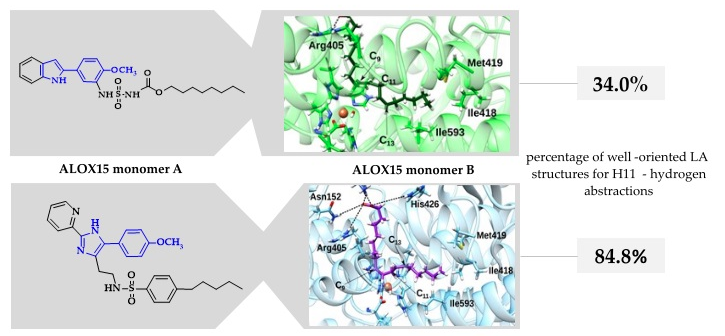Different Structures—Similar Effect: Do Substituted 5-(4-Methoxyphenyl)-1H-indoles and 5-(4-Methoxyphenyl)-1H-imidazoles Represent a Common Pharmacophore for Substrate Selective Inhibition of Linoleate Oxygenase Activity of ALOX15?
Zhuravlev, A.; Cruz, A.; Chen, X.; Aksenov, V.; Golovanov, A.; Lluch J. M.; Kuhn, H.; González-Lafont, À. Ivanov I.
Mammalian 15-lipoxygenases (ALOX15) are lipid peroxidizing enzymes that exhibit variable functionality in different cancer and inflammation models. The pathophysiological role of linoleic acid- and arachidonic acid-derived ALOX15 metabolites rendered this enzyme a target for pharmacological research. Several indole and imidazole derivatives inhibit the catalytic activity of rabbit ALOX15 in a substrate-specific manner, but the molecular basis for this allosteric inhibition remains unclear. Here, we attempt to define a common pharmacophore, which is critical for this allosteric inhibition. We found that substituted imidazoles induce weaker inhibitory effects when compared with the indole derivatives. In silico docking studies and molecular dynamics simulations using a dimeric allosteric enzyme model, in which the inhibitor occupies the substrate-binding pocket of one monomer, whereas the substrate fatty acid is bound at the catalytic center of another monomer within the ALOX15 dimer, indicated that chemical modification of the core pharmacophore alters the enzyme–inhibitor interactions, inducing a reduced inhibitory potency. In our dimeric ALOX15 model, the structural differences induced by inhibitor binding are translated to the hydrophobic dimerization cluster and affect the structures of enzyme–substrate complexes. These data are of particular importance since substrate-specific inhibition may contribute to elucidation of the putative roles of ALOX15 metabolites derived from different polyunsaturated fatty acids in mammalian pathophysiology.
